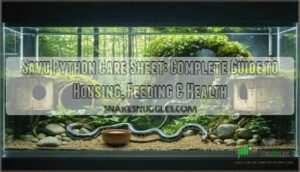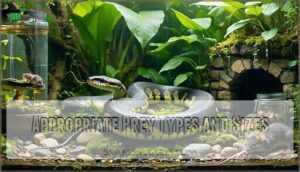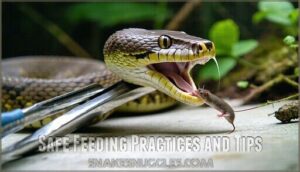This site is supported by our readers. We may earn a commission, at no cost to you, if you purchase through links.
 Your savu python care sheet starts with creating their perfect island retreat. You’ll need a 40-gallon enclosure with temperatures ranging from 78-82°F on the cool side to 88-92°F basking area, plus 50-60% humidity. These white-eyed beauties from Sawu Island thrive on aspen substrate, secure hides on both ends, and a soaking bowl.
Your savu python care sheet starts with creating their perfect island retreat. You’ll need a 40-gallon enclosure with temperatures ranging from 78-82°F on the cool side to 88-92°F basking area, plus 50-60% humidity. These white-eyed beauties from Sawu Island thrive on aspen substrate, secure hides on both ends, and a soaking bowl.
Feed frozen-thawed mice every 7-10 days for juveniles, 10-14 days for adults. Their calm nature makes handling a breeze, though they appreciate gentle movements.
Regular cleaning prevents issues, while their compact 4-5 foot adult size fits most homes perfectly. The secret to unlocking their full potential lies in understanding their unique behavioral patterns and seasonal needs.
Table Of Contents
- Key Takeaways
- Savu Python Origins and Natural Habitat
- Setting Up The Ideal Enclosure
- Temperature, Lighting, and Humidity Needs
- Feeding and Nutrition Guidelines
- Health, Handling, and Common Issues
- Frequently Asked Questions (FAQs)
- What is the average lifespan of a Savu python?
- How can I tell the gender of my Savu python?
- How big will the eggs be if I breed my Savu pythons?
- What signs of illness should I watch out for with my Savu python?
- How often do Savu pythons shed their skin?
- Can Savu pythons be housed with other snakes?
- What breeding age and season for Savu pythons?
- Do Savu pythons require veterinary checkups regularly?
- How long do Savu pythons typically live?
- Conclusion
Key Takeaways
- You’ll need a 40-gallon enclosure with proper temperature gradients (78-82°F cool side, 88-92°F basking area) and 50-60% humidity to replicate their native Sawu Island environment.
- Feed frozen-thawed mice every 7-10 days for juveniles and 10-14 days for adults – these compact pythons only reach 4-5 feet, making them perfect for smaller spaces.
- You’ll appreciate their calm, docile temperament that makes handling easy, though they still need gentle movements and proper support during interactions.
- Weekly spot-cleaning and monthly deep sanitization prevent most health issues, while watching for respiratory infections, mites, and feeding problems keeps your snake thriving.
Savu Python Origins and Natural Habitat
You’ll find your Savu python hails from the tiny Indonesian island of Sawu, where these compact serpents have mastered the art of hiding under stones in grasslands and rolling hills.
This remote island paradise with its dry climate has given us one of the world’s smallest python species, sporting those distinctive bright white eyes that earned them their alternate name.
Geographic Range and Distribution
Your Savu python’s entire world exists on tiny Sawu Island, Indonesia—making Liasis savuensis one of nature’s most geographically restricted serpents. This Endemic Status means Savu pythons have the smallest range of any python species, confined to just one small island in the Lesser Sundas.
Habitat Loss threatens their limited Island Geography, while Climate Impact and potential Species Migration concerns make captive breeding programs increasingly essential for conservation efforts. Understanding their native python habitats is essential for creating suitable environments in captivity.
Native Climate and Environmental Features
Understanding Sawu Island’s unique environment helps you create the perfect Savu python care setup. This Indonesian island features dry tropical forests with rolling hills and grasslands, quite different from typical rainforest habitats. Stone habitats provide natural hiding spots throughout the landscape.
Climate conditions remain warm year-round with lower humidity than neighboring islands. Your thermostat should maintain temperature control reflecting these drier tropical forests, while humidity levels stay moderate for ideal Savu Python Habitat replication.
Physical Appearance and Unique Traits
You’ll immediately recognize a Savu python by its striking bright white eyes, earning them the nickname "White Eyed Pythons."
These compact snakes showcase fascinating pattern development – hatchlings start pale orange and patternless, gradually developing intricate scale patterns and darker coloration as they mature.
Adult females reach 4-5 feet while males stay smaller at 3-4 feet, making them perfect apartment-friendly reptiles.
Setting Up The Ideal Enclosure
You’ll need to create a proper home for your Savu python that matches their simple needs while keeping them secure and comfortable.
Think of it like setting up a studio apartment for a very low-maintenance roommate who just wants the basics done right.
Recommended Enclosure Sizes for All Life Stages
Proper tank size makes or breaks your Savu python’s quality of life. Space requirements should match your snake’s body length for ideal habitat design and enclosure planning success.
Start hatchlings in 5-10 gallon enclosures or 6-quart tubs with adequate ventilation needs. Juveniles require 20-gallon long tanks, while adults thrive in 40-gallon breeder setups.
To guarantee the best results, research the Savu python care guidelines for creating an ideal environment.
Substrate Choices and Safe Materials
Your substrate choice creates the foundation for your Savu python’s comfort. Aspen bedding ranks as the top pick—it’s absorbent, easy to spot-clean, and naturally odor-resistant. Bark substrate and coconut fiber work well too, offering good moisture retention.
Mulch options like ReptiEarth and coconut chips provide natural aesthetics. Always avoid cedar or pine substrates, which contain harmful oils that can irritate your snake’s respiratory system.
For ideal snake health, consider using aspen bedding products that meet specific standards.
Essential Enclosure Accessories (hides, Water Bowls, Climbing Options)
Your snake enclosure needs key accessories for comfort and security. Provide multiple hiding places – one on the cool side and one near the basking spot. A sturdy water bowl prevents tipping while maintaining water quality.
Cork bark offers excellent climbing structures and decorative elements. Make certain substrate depth allows natural burrowing behaviors. These accessories create a functional, enriching environment.
Temperature, Lighting, and Humidity Needs
You’ll need to nail the temperature and humidity requirements to keep your Savu python thriving, since these small pythons are surprisingly sensitive to environmental changes despite their hardy reputation.
Getting the thermal gradient right isn’t just about comfort—it’s essential for proper digestion, immune function, and overall health in these compact Indonesian natives.
Creating Thermal Gradients and Basking Spots
Your Savu python needs proper temperature control to thrive. Create a thermal gradient with heat sources like heat pads or radiant heat panels on one side, controlled by a proportional thermostat.
- Hot side: 86-90°F basking spot for thermoregulation
- Cool side: 80-82°F ambient temperature for comfort
- Gradient creation: Position heat sources strategically for a smooth temperature shift
This setup mimics their natural habitat perfectly.
Maintaining Proper Humidity Levels
Getting humidity right isn’t rocket science, but your hygrometer becomes your best friend here. Keep levels between 50-70% using large water bowls near heat sources and ReptiEarth or coconut chips substrate.
Add humid hide boxes with sphagnum moss for shedding periods. Monitor with calibrated hygrometers and adjust ventilation as needed—misting systems work for stubborn dry spells.
Maintaining the ideal humidity management levels is essential for the health of your Savu Python.
Lighting Requirements and Day/night Cycles
Lighting controls your snake’s circadian rhythms and natural behaviors. Use a consistent photoperiod of 12 hours light and 12 hours darkness, managed with a timer or herpstat. While UVB lighting isn’t required, a low-intensity tube can benefit health. Keep nighttime completely dark to maintain proper cycles.
Monitor with your thermostat system for an ideal enclosure setup. Understanding the temperature humidity balance is vital for creating a suitable environment.
Feeding and Nutrition Guidelines
You’ll find that feeding your Savu python isn’t complicated, but getting the timing and prey size right makes all the difference in keeping your snake healthy and growing properly.
Feeding your Savu python right isn’t rocket science—timing and prey size are everything.
Unlike your pet dog who’ll remind you about dinner time, these patient hunters can wait weeks between meals, so you’ll need to stay on top of their feeding schedule.
Appropriate Prey Types and Sizes
Choosing the right prey for your Savu python doesn’t have to be rocket science. These compact pythons thrive on prekilled mice and small rats, making python feeding straightforward and safe.
- Mouse sizes: Adult female hopper mice or small adult mice work perfectly for most Savu pythons
- Rodent quality: Always choose high-quality frozen/thawed prey from reputable suppliers to guarantee snake health
- Feeding techniques: Use feeding tongs and feed in a separate container to prevent substrate ingestion and territorial behavior. When selecting prey, consider the importance of proper frozen mice storage to maintain nutritional value.
Feeding Frequency by Age and Size
Throughout your Savu python’s life, feeding schedules adapt to growth rates and dietary needs. Hatchlings thrive on weekly meals, matching their rapid development. As juveniles mature, extend meal frequency to every 7-10 days.
Adults need feeding every 10-14 days, preventing obesity while maintaining proper snake nutrition. Breeding females may require more frequent python feeding to support reproductive health and energy demands.
Safe Feeding Practices and Tips
The golden rule of Savu python feeding safety: always use feeding tongs when offering prekilled rats or mice. This prevents accidental bites and keeps your fingers looking like fingers, not snake snacks!
Feed your Savu python in a separate container to avoid substrate ingestion. Proper meal sizing means choosing prey roughly equal to your snake’s thickest body section. Thaw frozen rodents completely in warm water before serving.
Monitor feeding closely—even docile hatchlings can surprise you with their enthusiasm for dinner time.
Health, Handling, and Common Issues
You’ll need to stay vigilant about your Savu python’s health since these hardy snakes can hide illness well, and regular cleaning prevents most problems before they start.
While they’re generally calm and easy to handle, proper technique keeps both you and your snake safe during those necessary health checks and routine maintenance.
Routine Cleaning and Enclosure Hygiene
Clean enclosures weekly with spot-cleaning for waste and monthly deep sanitization. Use reptile-safe disinfection methods on all terrarium surfaces, replacing substrates when soiled. Wash water bowls thoroughly to prevent bacterial growth.
Proper substrate maintenance prevents odors and maintains humidity control. Regular enclosure sanitization keeps your snake healthy—think of it as basic housekeeping for reptile care success. Maintaining good snake enclosure cleanliness is essential for preventing diseases and promoting a healthy environment.
Preventing and Identifying Health Problems
Good hygiene sets the foundation, but vigilant health monitoring catches problems early.
Watch for respiratory infections—wheezing, open-mouth breathing signal potential serpentovirus affecting up to 40% of captive pythons. Snake mites appear as tiny moving dots, causing excessive soaking and restlessness.
Check for mouth rot symptoms like swollen gums or cheesy discharge. Proper veterinary care becomes critical when you spot lethargy, feeding refusal, or abnormal shedding patterns in your snake.
Safe Handling Techniques and Temperament
Savu pythons display calm temperament traits, making them excellent beginner snakes. These docile pythons rarely bite, but safety precautions include washing hands before and after contact.
When handling, support their body with gentle restraint using both hands. Move slowly and avoid sudden movements that trigger defensive snake behavior.
Proper handling tips include letting them settle after feeding and respecting their space during shed cycles for ideal snake care.
Quarantine and New Snake Introduction
Every new Savu python requires proper quarantine protocols before joining your collection. **Isolate new snakes for at least three months in separate enclosures to prevent disease transmission.
**
This snake acclimation period allows you to monitor for mites, respiratory issues, and feeding problems. **Proper introduction methods protect your existing captive snakes while ensuring your new addition thrives in its forever home.
Frequently Asked Questions (FAQs)
What is the average lifespan of a Savu python?
Like a treasured timekeeper that marks decades, your Savu python can live 20-25 years in captivity with proper care, though wild specimens usually reach 10-15 years due to natural challenges.
How can I tell the gender of my Savu python?
Determining gender requires specialized techniques. You’ll need to examine tail shape differences, look for anal spurs, or use professional methods like probing.
Males usually have longer, thicker tails that taper suddenly, while females have shorter, evenly-tapered tails.
How big will the eggs be if I breed my Savu pythons?
Like tiny treasures in a jewelry box, your Savu python’s eggs will measure about 2⅓ inches by 1¼ inches, weighing roughly 35 grams each. You’ll usually see five to ten eggs per clutch.
What signs of illness should I watch out for with my Savu python?
Watch for respiratory infections (mouth breathing, wheezing), mites (tiny moving dots), stuck shed (retained skin pieces), regurgitation, lethargy, loss of appetite, abnormal posture, and discharge from eyes or mouth.
How often do Savu pythons shed their skin?
Your Savu python’s skin renewal follows nature’s clock, but here’s what you’ll notice: young pythons shed every 4-6 weeks while adults stretch it to 6-8 weeks, creating that perfect fresh-skin feeling throughout their lifetime.
Can Savu pythons be housed with other snakes?
You shouldn’t house Savu pythons with other snakes. They’re naturally solitary creatures who compete for food and territory.
They still have natural instincts to fight for dominance, food, and mates. Keep them separate for their wellbeing.
What breeding age and season for Savu pythons?
Like clockwork, your snake’s biological calendar starts ticking around 3-5 years old. Savu pythons can grow to their adult size and length in just two years, but they may start to become interested in breeding by the time they are 3 to 5 years old.
Do Savu pythons require veterinary checkups regularly?
You don’t need routine vet visits for healthy Savu pythons. Schedule checkups only when you notice behavioral changes, feeding issues, or visible health problems like mites or respiratory symptoms.
How long do Savu pythons typically live?
Back when your grandmother kept pythons in old steamer trunks, captive Savu pythons live 20-25 years.
Proper husbandry unlocks their longevity potential, making these charming snakes lasting companions. Their compact size doesn’t compromise their impressive lifespan.
Conclusion
Despite theories suggesting complex care requirements, Savu pythons actually adapt well to standard python husbandry practices.
Following this thorough savu python care sheet ensures your snake thrives in captivity. You’ve learned the essentials: proper enclosure setup, temperature gradients, appropriate feeding schedules, and health monitoring techniques.
These hardy serpents reward consistent care with docile temperaments and impressive longevity. Remember that patience and observation are your best tools for successful python keeping.














